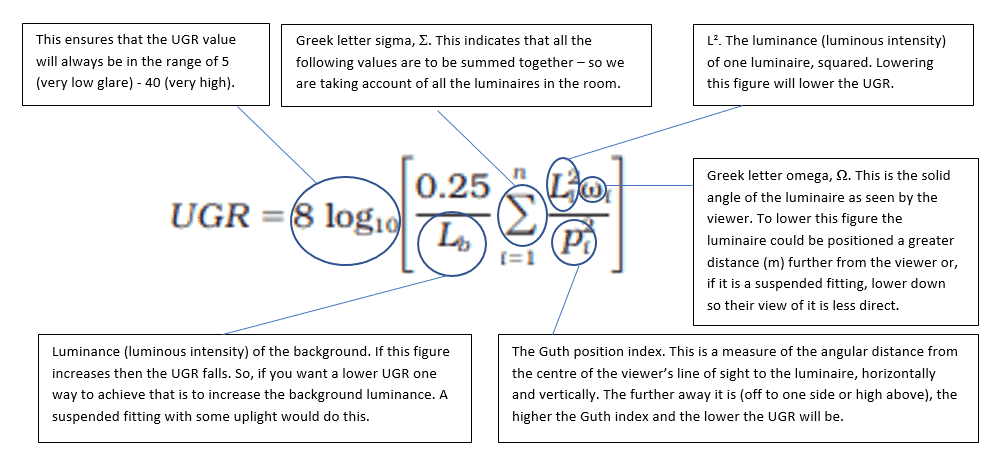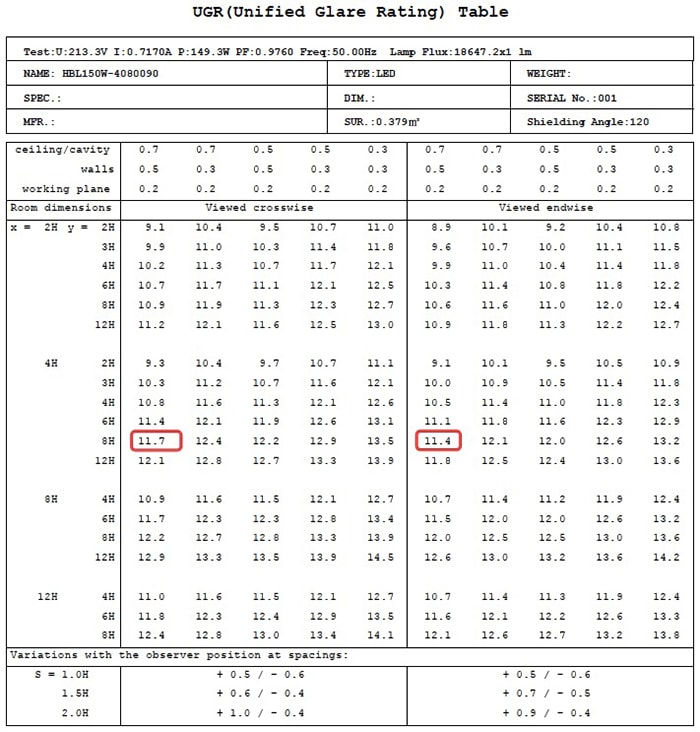Introduction to Glare
Glare is a sensory response to excessive light, similar to how you feel when you are in a brightly lit room and you cannot see very clearly. Glare is subjective, and the effect varies widely from person to person. The eye is refracted within the lens by an amount dependent upon the level of ambient lighting. This means that older people generally have less control over where objects in front of their eyes will be focused on. This is why older people can be more sensitive to glare.
What is UGR?
Unified Glare Rating is a scale that predicts the discomfort-causing glare coming from an entire lighting scheme. This means you can predict the amount of discomfort glare based on an overall average of a light system’s individual components. As a result, you can have an idea of what kind of glare each fixture or bulb is having and then make adjustments for it. This helps to avoid uncomfortable glare that can cause headaches or fatigue, making lighting more human-friendly!
What is UGR19?
- What exactly is a UGR<19 light fitting? UGR19 stands for “Unified Glare Rating of 19 or less”. , but strictly speaking it refers to the installation rather than a specific product. However, a lot of manufacturers sell products that are rated under UGR 19. What does this mean?
- It means that the lamp’s light distribution will be helpful to the lighting designer to get a result of UGR<19.
- Generally, fittings whose UGR is less than 19 are designed to have a beam angle that’s narrower and more directional than the general light fittings.
How is UGR calculated?
-
- The UGR is only relevant for indoor lighting installations. It cannot be used for street lighting or outdoor lighting. It is measured using a formula. The UGR is the amount of glare or distraction from a luminaire divided by the luminance of the room’s background light. The lower the UGR, the more acceptable the glare. For example, a low UGR of 10 means the glare will not be noticed, while a UGR of 30 will definitely cause distraction.
- The formula for calculating the position and brightness of glare sources for a given direction is quite accurate, but it is relatively difficult to work with. It can be calculated using computer software.
- UGR is calculated in a wide variety of design software packages such as Relux, Dialux, Agi32, and others.

Unified Glare Rating Formula
Recommended UGR limits
|
UGR limits for interior areas, tasks and activities |
||
| BSEN12464 table | Type of area, task or activity (no. of sub-divisions) | Maximum UGR |
| 5.1 | Traffic zones inside buildings (4) | 25-28 |
| 5.2 | Rest, sanitation & first aid rooms (6) | 16-25 |
| 5.3 | Control rooms (2) | 19-25 |
| 5.4 | Store rooms & cold stores (2) | 25 |
| 5.5 | Storage rack areas (4) | 22 |
| 5.6 | Industrial activities & crafts – Agriculture (4) | 25 |
| 5.7 | Industrial activities & crafts – bakeries (2) | 22 |
| 5.8 | Industrial activities & crafts – Cement, cement goods (4) | 25-28 |
| 5.9 | Industrial activities & crafts – Ceramics, tiles etc (7) | 16-28 |
| 5.10 | Industrial activities & crafts – Chemical, plastic etc (8) | 16-28 |
| 5.11 | Industrial activities & crafts – Electrical & electronics (6) | 16-25 |
| 5.12 | Industrial activities & crafts – Foodstuffs, luxury food (8) | 16-25 |
| 5.13 | Industrial activities & crafts – Foundries & casting (11) | 22-25 |
| 5.14 | Industrial activities & crafts – Hairdressers (1) | 19 |
| 5.15 | Industrial activities & crafts – Jewellery mfg. (4) | 16-19 |
| 5.16 | Industrial activities & crafts – Laundries, dry cleaning (4) | 19-25 |
| 5.17 | Industrial activities & crafts – Leather, leather goods (9) | 16-25 |
| 5.18 | Industrial activities & crafts – Metal working (14) | 19-25 |
| 5.19 | Industrial activities & crafts – Paper (3) | 22-25 |
| 5.20 | Industrial activities & crafts – Power stations (5) | 16-28 |
| 5.21 | Printers (5) | 16-19 |
| 5.22 | Industrial activities & crafts – Rolling mills, iron, steel (9) | 22-28 |
| 5.23 | Industrial activities & crafts – Textiles (13) | 19-28 |
| 5.24 | Industrial activities & crafts – Vehicles (6) | 19-22 |
| 5.25 | Industrial activities & crafts – Wood (9) | 19-28 |
| 5.26 | Offices (7) | 16-25 |
| 5.27 | Retail premises (3) | 19-22 |
| 5.28 | Places of public assembly, general areas (4) | 22-15 |
| 5.29 | Places of public assembly – Restaurants & hotels (7) | 19-25 |
| 5.30 | Places of public assembly – Theatres, cinemas etc (4) | 22 |
| 5.31 | Places of public assembly – Trade fairs & exhibitions (1) | 22 |
| 5.32 | Places of public assembly – Museums (2) | n/a |
| 5.33 | Places of public assembly – Libraries (3) | 19 |
| 5.34 | Places of public assembly – Public car parks indoor (5) | 19-25 |
| 5.35 | Educational premises – Nursery school, play school (3) | 19-22 |
| 5.36 | Educational premises – Educational buildings (26) | 16-25 |
| 5.37 | Health care premises – Rooms for general use (8) | 22 |
| 5.38 | Health care premises – Staff rooms (2) | 19 |
| 5.39 | Health care premises – Wards, maternity wards (6) | 19-22 |
| 5.40 | Health care premises – Examination rooms (general) (2) | 19 |
| 5.41 | Health care premises – Eye examination rooms (2) | 19 |
| 5.42 | Health care premises – Ear examination rooms (2) | 19 |
| 5.43 | Health care premises – Scanner rooms (2) | 19 |
| 5.44 | Health care premises – Delivery rooms (2) | 19 |
| 5.45 | Health care premises – Treatment rooms (general) (6) | 19 |
| 5.46 | Health care premises – Operating areas (3) | 19 |
| 5.47 | Health care premises – Intensive care unit (4) | 19 |
| 5.48 | Health care premises – Dentists (4) | 19 |
| 5.49 | Health care premises – Laboratories & pharmacies (2) | 19 |
| 5.50 | Health care premises – Decontamination rooms (2) | 22 |
| 5.51 | Health care premises – Autopsy rooms & mortuaries (2) | 19 |
| 5.52 | Transportation areas – Airports (11) | 16-25 |
| 5.53 | Transportation areas – Railway installations (11) | 19-28 |
How to find the UGR values of a product?
- Ask for an IES pdf file(photometric file) from your lighting supplier
- Open the photometric file and find the page with the UGR tab
- Navigate to 4H x 8H Room Dimensions, and the UGR value will be in the first column(under a standard room reflectance of 0.7/0.5/0.2).
How to reduce the UGR?
- Here are some methods used to reduce the glare of a lighting fixture
- Micro prismatic technology can be used to develop special diffusers that would disperse light from every LEDs, making it possible to achieve a homogeneous light with optimum levels of contrast without any direct or reflected glare.
- Designing the secondary reflector system is possibly the most important part of the design process. This is where the primary reflector redirects light from the LEDs into the secondary reflector, which then distributes and directs the light as needed. By this way, the glare can be reduced obviously.
- Increase the background luminance to decrease the contrast between the fittings and the background and this will reduce the UGR.
- Use a narrow beam angle such as 60degree or smaller
- Install the lighting fixture away from the viewer so they are not shining in their eyes
What manufacturers can do to reduce the UGR?
-
- To reduce the UGR of UFO LED High Bay Light, for example, we use a specially designed circle lens to reduce the glare in the first step, then we designed a narrow beam angle of 60degree and 90degree to decrease more glare, finally, if you require a minimized glare, we would recommend using our patented designed Polycarbonate reflector(diffuser) to achieve the lowest glare(A polycarbonate bottom cap is strongly recommended to reduce the glare).
- Below is the UGR value for our LED High bay light with different beam angles(60degree, 90degree, and 120degree), with a PC reflector without a bottom cap, with PC reflector including bottom cap and with aluminum reflector.

150w LED High Bay Light with 120degree lens UGR<24

150W LED High Bay Light 90degree lens UGR<19

150W LED High Bay Light 60degree lens UGR<19

150W LED High Bay Light with Aluminum reflector UGR value<19

150W LED High Bay Light with Polycarbonate diffuser without bottom cap UGR value<16

150W LED High Bay Light with Polycarbonate diffuser with bottom cap UGR value<12
To get the full IES pdf file(photometric file), please contact us.
The above-tested product link is as below:
UGR<19 150W UFO LED High Bay Light with 60/90/120 degree lens
UGR<12 150W UFO LED High Bay Light with PC Reflector
UGR<19 150W UFO LED High Bay Light with Aluminum Reflector
If you are looking for a linear LED High Bay Light with UGR<19, the below product is recommended:


